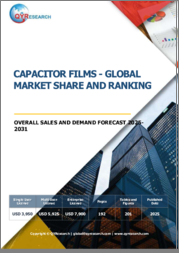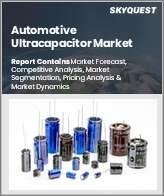
|
시장보고서
상품코드
1541352
디스크리트 커패시터 시장 보고서 : 유형별, 용도별, 지역별(2024-2032년)Discrete Capacitors Market Report by Type, Application, and Region 2024-2032 |
||||||
세계 디스크리트 커패시터 시장 규모는 2023년 92억 달러에 달했습니다. 향후 IMARC Group은 2024년부터 2032년까지 3.2%의 연평균 성장률(CAGR)을 보이며 2032년에는 124억 달러에 달할 것으로 예측했습니다.
디스크리트 커패시터는 에너지를 저장하고 절연체로 분리된 두 개의 판에 양극과 음극의 에너지를 저장하는 전기 부품입니다. 일반적으로 플라스틱, 세라믹, 유리, 도자기, 운모 및 기타 재료로 만들어집니다. 전원 공급 장치(PSU)에 사용되며 리플 필터를 통해 전압을 평활화하는 데 사용됩니다. 커패시터는 일반적으로 증폭기 스테이지 간의 신호 결합 및 다양한 전자 장비의 전원 공급 시스템에 사용됩니다. 디스크리트 커패시터는 에너지 손실을 최소화하여 전하를 방전 및 저장하고 다른 배터리에 비해 수명이 깁니다. 자동차 산업, 의료 산업, 통신 산업, 항공우주 산업, 방위 산업 등에서 광범위하게 사용되고 있습니다.
주거, 상업 및 산업 공간에서 난방, 환기 및 공조(HVAC) 시스템 설치가 증가함에 따라 전 세계 디스크리트 커패시터 수요에 긍정적인 영향을 미치는 주요 요인 중 하나입니다. 또한, 다양한 산업 분야에서 전력 공급 및 전송을 위한 효율적인 장치에 대한 수요가 증가하고 있는 것도 시장 성장에 기여하고 있습니다. 또한, 디스크리트 커패시터는 자동차 산업에서 효율적인 충전 시스템에 사용되고 있습니다. 이는 탄소 배출에 대한 우려 증가로 인한 하이브리드 및 전기자동차(H/EV)에 대한 수요 증가와 함께 시장을 주도하고 있습니다. 이와 더불어, 환경 문제에 대한 관심과 에너지 안보에 대한 관심이 높아지면서 전 세계적으로 재생에너지와 스마트 그리드 도입이 증가하고 있습니다. 여기에 스마트폰, 노트북, 스마트 웨어러블과 같은 소비자 전자제품의 판매 증가도 시장 성장을 견인하고 있습니다. 또한, 사물인터넷(IoT)과 센서 장치의 통합은 업계 진입 기업들에게 유리한 성장 기회를 제공할 것으로 예상됩니다.
본 보고서에서 다루는 주요 질문들
- 2023년 세계 디스크리트 커패시터 시장 규모는?
- 2024-2032년 디스크리트 커패시터 시장 세계 시장 성장률은?
- 세계 디스크리트 커패시터 시장을 이끄는 주요 요인은 무엇인가?
- COVID-19가 세계 디스크리트 커패시터 시장에 미치는 영향은?
- 세계 디스크리트 커패시터 시장 유형별 분류는?
- 세계 디스크리트 커패시터 시장의 용도는?
- 세계 디스크리트 커패시터 시장의 주요 지역은?
- 세계 디스크리트 커패시터 시장의 주요 진출 기업은?
목차
제1장 서문
제2장 조사 범위와 조사 방법
- 조사 목적
- 이해관계자
- 데이터 소스
- 1차 정보
- 2차 정보
- 시장 추정
- 상향식 접근
- 하향식 접근
- 조사 방법
제3장 주요 요약
제4장 소개
- 개요
- 주요 업계 동향
제5장 세계의 디스크리트 커패시터 시장
- 시장 개요
- 시장 실적
- COVID-19의 영향
- 시장 예측
제6장 시장 내역 : 유형별
- 세라믹 커패시터
- 알루미늄 커패시터
- 종이·플라스틱 AC·DC 필름 커패시터
- 탄탈 커패시터
- 기타
제7장 시장 내역 : 용도별
- 통신
- 컴퓨터
- 가전제품
- 자동차
- 항공우주와 방위
- 기타
제8장 시장 내역 : 지역별
- 북미
- 미국
- 캐나다
- 아시아태평양
- 중국
- 일본
- 인도
- 한국
- 호주
- 인도네시아
- 기타
- 유럽
- 독일
- 프랑스
- 영국
- 이탈리아
- 스페인
- 러시아
- 기타
- 라틴아메리카
- 브라질
- 멕시코
- 기타
- 중동 및 아프리카
- 시장 동향
- 시장 내역 : 국가별
- 시장 예측
제9장 SWOT 분석
- 개요
- 강점
- 약점
- 기회
- 위협
제10장 밸류체인 분석
제11장 Porter's Five Forces 분석
- 개요
- 구매자의 교섭력
- 공급 기업의 교섭력
- 경쟁 정도
- 신규 참여업체의 위협
- 대체품의 위협
제12장 가격 분석
제13장 경쟁 상황
- 시장 구조
- 주요 기업
- 주요 기업 개요
- AFM Microelectronics Inc.
- American Technical Ceramics Corporation(Kyocera)
- AVX Corporation(Kyocera)
- KEMET Corporation(Yageo Corporation)
- Matsuo Electric Co. Ltd.(Nippon Chemi-Con Corp.)
- Maxwell Technologies(Tesla Inc.)
- Murata Manufacturing
- Taiyo Yuden
- TDK Ltd.
The global discrete capacitors market size reached US$ 9.2 Billion in 2023. Looking forward, IMARC Group expects the market to reach US$ 12.4 Billion by 2032, exhibiting a growth rate (CAGR) of 3.2% during 2024-2032.
Discrete capacitors are electrical components that store energy and hold positive and negative energy on two separate plates separated by an insulator. They are generally made from materials including plastic, ceramic, glass, porcelain, and mica. They are used in power supply units (PSUs) that smooth out voltage through filter ripple. They are commonly utilized for coupling signals between stages of amplifiers and in power supply systems of various electronic devices. Discrete capacitors discharge and preserve charges with minimal loss of energy and have a long service life as compared to other batteries. They find extensive applications in the automotive, medical, telecommunications, aerospace, and defense industries.
The increasing installation of heating, ventilation, and air conditioning (HVAC) systems in residential, commercial, and industrial spaces represents one of the major factors positively influencing the demand for discrete capacitors worldwide. In addition, the rising demand for efficient devices for supplying and transmitting electricity across various industries is contributing to the market growth. Moreover, discrete capacitors are employed in the automotive industry for effectively charging systems. This, in confluence with the escalating demand for hybrid and electric vehicles (H/EVs) due to growing concerns about carbon emissions, is driving the market. Besides this, increasing environmental concerns and energy security among the masses are boosting the adoption of renewable energy and smart grids around the world. This, along with the rising sales of consumer electronic products like smartphones, laptops, and smart wearables, is propelling the market growth. Furthermore, the integration of the Internet of Things (IoT) and sensor devices are anticipated to offer lucrative growth opportunities to industry players.
Key Market Segmentation:
IMARC Group provides an analysis of the key trends in each sub-segment of the global discrete capacitors market report, along with forecasts at the global, regional and country level from 2024-2032. Our report has categorized the market based on type and application.
Breakup by Type:
Ceramic Capacitor
Aluminium Capacitor
Paper & Plastic AC & DC Film Capacitor
Tantalum Capacitor
Others
Ceramic capacitors dominate the market as they are reliable and available in various shapes and sizes.
Breakup by Application:
Telecommunication
Computers
Consumer Electronics
Automotive
Aerospace and Defense
Others
Discrete capacitors find extensive application in consumer electronics.
Breakup by Region:
North America
United States
Canada
Asia Pacific
China
Japan
India
South Korea
Australia
Indonesia
Others
Europe
Germany
France
United Kingdom
Italy
Spain
Russia
Others
Latin America
Brazil
Mexico
Others
Middle East and Africa
The Asia Pacific holds the majority of the global discrete capacitors market share as it is one of the biggest manufacturers of discrete capacitors.
Competitive Landscape:
The competitive landscape of the market has been analyzed in the report, along with the detailed profiles of the major players operating in the industry. Some of these players are AFM Microelectronics Inc., American Technical Ceramics Corporation (Kyocera), AVX Corporation (Kyocera), KEMET Corporation (Yageo Corporation), Matsuo Electric Co. Ltd. (Nippon Chemi-Con Corp.), Maxwell Technologies (Tesla Inc.), Murata Manufacturing, Taiyo Yuden and TDK Ltd.
Key Questions Answered in This Report
- 1. What was the size of the global discrete capacitors market in 2023?
- 2. What is the expected growth rate of the global discrete capacitors market during 2024-2032?
- 3. What are the key factors driving the global discrete capacitors market?
- 4. What has been the impact of COVID-19 on the global discrete capacitors market?
- 5. What is the breakup of the global discrete capacitors market based on the type?
- 6. What is the breakup of the global discrete capacitors market based on the application?
- 7. What are the key regions in the global discrete capacitors market?
- 8. Who are the key players/companies in the global discrete capacitors market?
Table of Contents
1 Preface
2 Scope and Methodology
- 2.1 Objectives of the Study
- 2.2 Stakeholders
- 2.3 Data Sources
- 2.3.1 Primary Sources
- 2.3.2 Secondary Sources
- 2.4 Market Estimation
- 2.4.1 Bottom-Up Approach
- 2.4.2 Top-Down Approach
- 2.5 Forecasting Methodology
3 Executive Summary
4 Introduction
- 4.1 Overview
- 4.2 Key Industry Trends
5 Global Discrete Capacitors Market
- 5.1 Market Overview
- 5.2 Market Performance
- 5.3 Impact of COVID-19
- 5.4 Market Forecast
6 Market Breakup by Type
- 6.1 Ceramic Capacitor
- 6.1.1 Market Trends
- 6.1.2 Market Forecast
- 6.2 Aluminium Capacitor
- 6.2.1 Market Trends
- 6.2.2 Market Forecast
- 6.3 Paper & Plastic AC & DC Film Capacitor
- 6.3.1 Market Trends
- 6.3.2 Market Forecast
- 6.4 Tantalum Capacitor
- 6.4.1 Market Trends
- 6.4.2 Market Forecast
- 6.5 Others
- 6.5.1 Market Trends
- 6.5.2 Market Forecast
7 Market Breakup by Application
- 7.1 Telecommunication
- 7.1.1 Market Trends
- 7.1.2 Market Forecast
- 7.2 Computers
- 7.2.1 Market Trends
- 7.2.2 Market Forecast
- 7.3 Consumer Electronics
- 7.3.1 Market Trends
- 7.3.2 Market Forecast
- 7.4 Automotive
- 7.4.1 Market Trends
- 7.4.2 Market Forecast
- 7.5 Aerospace and Defense
- 7.5.1 Market Trends
- 7.5.2 Market Forecast
- 7.6 Others
- 7.6.1 Market Trends
- 7.6.2 Market Forecast
8 Market Breakup by Region
- 8.1 North America
- 8.1.1 United States
- 8.1.1.1 Market Trends
- 8.1.1.2 Market Forecast
- 8.1.2 Canada
- 8.1.2.1 Market Trends
- 8.1.2.2 Market Forecast
- 8.1.1 United States
- 8.2 Asia Pacific
- 8.2.1 China
- 8.2.1.1 Market Trends
- 8.2.1.2 Market Forecast
- 8.2.2 Japan
- 8.2.2.1 Market Trends
- 8.2.2.2 Market Forecast
- 8.2.3 India
- 8.2.3.1 Market Trends
- 8.2.3.2 Market Forecast
- 8.2.4 South Korea
- 8.2.4.1 Market Trends
- 8.2.4.2 Market Forecast
- 8.2.5 Australia
- 8.2.5.1 Market Trends
- 8.2.5.2 Market Forecast
- 8.2.6 Indonesia
- 8.2.6.1 Market Trends
- 8.2.6.2 Market Forecast
- 8.2.7 Others
- 8.2.7.1 Market Trends
- 8.2.7.2 Market Forecast
- 8.2.1 China
- 8.3 Europe
- 8.3.1 Germany
- 8.3.1.1 Market Trends
- 8.3.1.2 Market Forecast
- 8.3.2 France
- 8.3.2.1 Market Trends
- 8.3.2.2 Market Forecast
- 8.3.3 United Kingdom
- 8.3.3.1 Market Trends
- 8.3.3.2 Market Forecast
- 8.3.4 Italy
- 8.3.4.1 Market Trends
- 8.3.4.2 Market Forecast
- 8.3.5 Spain
- 8.3.5.1 Market Trends
- 8.3.5.2 Market Forecast
- 8.3.6 Russia
- 8.3.6.1 Market Trends
- 8.3.6.2 Market Forecast
- 8.3.7 Others
- 8.3.7.1 Market Trends
- 8.3.7.2 Market Forecast
- 8.3.1 Germany
- 8.4 Latin America
- 8.4.1 Brazil
- 8.4.1.1 Market Trends
- 8.4.1.2 Market Forecast
- 8.4.2 Mexico
- 8.4.2.1 Market Trends
- 8.4.2.2 Market Forecast
- 8.4.3 Others
- 8.4.3.1 Market Trends
- 8.4.3.2 Market Forecast
- 8.4.1 Brazil
- 8.5 Middle East and Africa
- 8.5.1 Market Trends
- 8.5.2 Market Breakup by Country
- 8.5.3 Market Forecast
9 SWOT Analysis
- 9.1 Overview
- 9.2 Strengths
- 9.3 Weaknesses
- 9.4 Opportunities
- 9.5 Threats
10 Value Chain Analysis
11 Porters Five Forces Analysis
- 11.1 Overview
- 11.2 Bargaining Power of Buyers
- 11.3 Bargaining Power of Suppliers
- 11.4 Degree of Competition
- 11.5 Threat of New Entrants
- 11.6 Threat of Substitutes
12 Price Analysis
13 Competitive Landscape
- 13.1 Market Structure
- 13.2 Key Players
- 13.3 Profiles of Key Players
- 13.3.1 AFM Microelectronics Inc.
- 13.3.1.1 Company Overview
- 13.3.1.2 Product Portfolio
- 13.3.2 American Technical Ceramics Corporation (Kyocera)
- 13.3.2.1 Company Overview
- 13.3.2.2 Product Portfolio
- 13.3.3 AVX Corporation (Kyocera)
- 13.3.3.1 Company Overview
- 13.3.3.2 Product Portfolio
- 13.3.4 KEMET Corporation (Yageo Corporation)
- 13.3.4.1 Company Overview
- 13.3.4.2 Product Portfolio
- 13.3.5 Matsuo Electric Co. Ltd. (Nippon Chemi-Con Corp.)
- 13.3.5.1 Company Overview
- 13.3.5.2 Product Portfolio
- 13.3.6 Maxwell Technologies (Tesla Inc.)
- 13.3.6.1 Company Overview
- 13.3.6.2 Product Portfolio
- 13.3.7 Murata Manufacturing
- 13.3.7.1 Company Overview
- 13.3.7.2 Product Portfolio
- 13.3.7.3 Financials
- 13.3.7.4 SWOT Analysis
- 13.3.8 Taiyo Yuden
- 13.3.8.1 Company Overview
- 13.3.8.2 Product Portfolio
- 13.3.8.3 Financials
- 13.3.9 TDK Ltd.
- 13.3.9.1 Company Overview
- 13.3.9.2 Product Portfolio
- 13.3.9.3 Financials
- 13.3.9.4 SWOT Analysis
- 13.3.1 AFM Microelectronics Inc.



















